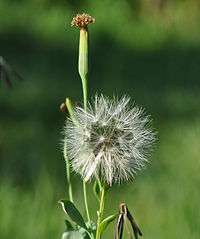Porophyllum ruderale
| Porophyllum ruderale | |
|---|---|
 | |
| Scientific classification | |
| Kingdom: | Plantae |
| (unranked): | Angiosperms |
| (unranked): | Eudicots |
| (unranked): | Asterids |
| Order: | Asterales |
| Family: | Asteraceae |
| Tribe: | Tageteae |
| Genus: | Porophyllum |
| Species: | P. ruderale |
| Binomial name | |
| Porophyllum ruderale (Jacq.) Cass. | |
Porophyllum ruderale is an herbaceous annual plant whose leaves can be used for seasoning food. The taste has been described as "somewhere between arugula, cilantro and rue."[1] The plant is commonly grown in Mexico and South America for use in salsas. When fully grown, this plant grows to about 5 feet in height and 3 feet in diameter.
The plant is easy to grow from seed in a well drained soil, which should be allowed to dry between watering.
Culture

Having been used by many cultures, Porophyllum ruderale is known by many names, including Bolivian coriander, quillquiña (also spelled quirquiña or quilquiña), yerba porosa, killi, pápalo, tepegua, "mampuritu" and pápaloquelite. Despite the name "Bolivian coriander", this plant is not botanically related to Coriandrum sativum.
This plant is known in Mexico as pápaloquelite, commonly accompanying the famous Mexican tacos. Not all Mexicans enjoy its taste, but experts claim that it gives a better flavor to tacos and typical Mexican salsas and soups.
In Puebla cuisine, pápalo is used as a condiment on traditional cemita sandwiches, a regional type of Mexican torta.
Papalo was used in the Azteca era, but never as medicine, only as food.
One study claims that Papalo exhibits some health benefits such as: lowering cholesterol, lowering blood pressure, and aiding digestion. [2]
References
- ↑ Green, Aliza (2006). Field Guide to Herbs & Spices: how to identify, select, and use virtually every seasoning at the market. Philadelphia: Quirk Books. p. 67. ISBN 1594740828.
- ↑ http://www.tipsdenutricion.com/ventajas-de-consumir-papalo-papaloquelite/572/
External links
 Media related to Porophyllum ruderale at Wikimedia Commons
Media related to Porophyllum ruderale at Wikimedia Commons
Seed sources
2011-- http://www.eonseed.com/catalog501.html
2012-- http://www.chilternseeds.co.uk/item.php?id=1388L
2013-- http://www.seedlibrary.org/papalo.html